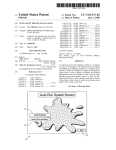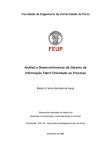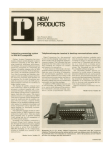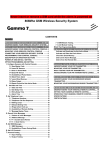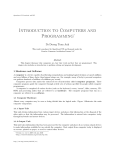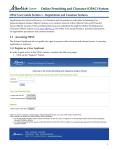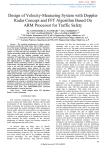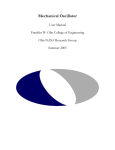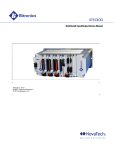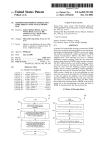Download Message monitor, analyzer, recorder and viewer in a publisher
Transcript
US008037173B2 (12) United States Patent US 8,037,173 B2 (10) Patent N0.: (45) Date of Patent: Tuckey et al. (54) MESSAGE MONITOR, ANALYZER, RECORDER AND VIEWER IN A PUBLISHER-SUBSCRIBER ENVIRONMENT Oct. 11, 2011 2007/0223533 A1 * 9/2007 Kirrmann et a1. ........... .. 370/469 2008/0120080 A1* 5/2008 Nasle 2008/0215727 A1* 9/2008 Denis et a1. ................. .. 709/224 . . . . . . . . . . . . . . . . .. 703/13 OTHER PUBLICATIONS (75) Inventors: David T. Tuckey, Victoria (CA); Basem ElWarry, Langford (CA) (73) Assignee: Schneider Electric USA, Inc., Palatine, IL (US) Notice: Subject to any disclaimer, the term of this patent is extended or adjusted under 35 U.S.C. 154(b) by 307 days. (21) Appl. N0.: 12/130,2s4 (22) Filed: May 30, 2008 (65) Areva, dated Dec. 21, 2007; 126 pages. Written Opinion corresponding to co-pending International Patent Application Serial No. PCT/US2009/045311, European Patent Of?ce, dated Oct. 2, 2009, 6 pages. International Search Report corresponding to co-pending Interna tional Patent Application Serial No. PCT/US2009/04531 1, European Patent Of?ce, dated Oct. 2, 2009, 4 pages. Omicron “IEC 61850iAn Important Standard for the Electrical Prior Publication Data US 2009/0300165 A1 Analysis of Recording Elements in Wide Area Monitoring Systems by Damien Tholomier and Alexander Apo stolov (downloaded from www.areva-td.com Sep. 22, 2008); 10 pages. BiTronics M871, Single Line, Dual Bus Modular IED by Areva (downloaded from www.areva-td.com Sep. 22, 2008); 2 pages. BiTronics M871 Monitoring and Recording IED by Areva, dated Sep. 22, 2008; 1 page. Bitronics M87X Monitoring & Recording IED User Manual by Power Industry” XP-00251152; dated 2006 (4 pages). Dec. 3, 2009 * cited by examiner (51) Int. Cl. G06F 15/16 G06F 15/173 (52) (58) (2006.01) (2006.01) Primary Examiner * Ian N Moore Assistant Examiner * Jenee Alexander US. Cl. ....... .. 709/224; 709/203; 709/217; 709/223 Field of Classi?cation Search ........ .. 709/2l7i2l9, 709/223i226; 714/14, 22; 707/100*104.1; 713/30(L340 See application ?le for complete search history. (56) (57) ABSTRACT A method of performing a sequence-of-events analysis in a power monitoring system includes the acts of monitoring, receiving, analyzing, and storing. The act of monitoring includes monitoring messages published by multiple power References Cited monitors over a peer-to-peer communications network. The U.S. PATENT DOCUMENTS messages include electrical power monitoring parameters. The act of receiving includes receiving the published mes sages in a subscriber intelligent electronic device in the power monitoring system. The act of analyzing includes analyzing i 7’103’874 B2 * glilcr?irlllseit?l' """"""" " 9/2006 Mcconum e't 709/224 7,558,703 B2 * 7/2009 Stoupis et a1, ,,,,,,,,,,,,,, ,, 709/223 at least a portion of the received messages, performing statis 9/2002 Hammond et a1. tical analysis and/or continuously scanning for an event of 2002/0138785 A1 2002/0173927 A1 : 11/2002 vandlver ~~~~~~~~~~~~~~~~~~~~~ ~~ 702/122 535F010 """""""" " 713/201 interest. The act of storing includes storing at least one record including at least one of statistical data or event of interest 2005/0144437 A1* 2006/0007901 A1* 6/2005 Ransom et al. ............. .. 713/151 1/2006 Roskowski et al. ......... .. 370/338 data: 2007/0114987 A1 5/2007 Kagan 16 Claims, 3 Drawing Sheets 110a\ 110b\ IED 140 i r 11OC\ IED i 125 IED i K120 y 130\ ED 150\ Workstation 132 Display US. Patent 0a. 11, 2011 Sheet 2 013 US 8,037,173 B2 US 8,037,173 B2 1 2 MESSAGE MONITOR, ANALYZER, detected. The instruction of storing includes storing at least RECORDER AND VIEWER IN A PUBLISHER-SUBSCRIBER ENVIRONMENT one record including at least one of statistical data and/or event of interest data. FIELD OF THE INVENTION According to other aspects of the present concepts, a method of performing a sequence-of-events analysis in a poWer monitoring system includes the acts of monitoring, The present invention relates generally to a sequence-of event analysis in a utility monitoring system having a plural receiving, analyZing, and storing. The act of monitoring includes monitoring messages published by multiple poWer ity of publisher intelligent electrical devices, and in particu monitors over a peer-to-peer communications netWork. The lar, to a poWer monitoring system having at least one messages include electrical poWer monitoring parameters. The act of receiving includes receiving the published mes subscriber intelligent electronic device. sages in a subscriber intelligent electronic device in the poWer BACKGROUND OF THE INVENTION monitoring system. The act of analyZing includes analyZing Utility systems, such as an electrical utility system, are monitored using a netWork of intelligent electronic devices at least a portion of the received messages, performing statis tical analysis and/or continuously scanning for an event of interest. The act of storing includes storing at least one record (“IEDs”) coupled to a Workstation for monitoring various parameters of the electrical utility system. The netWork of data. IEDs and the Workstation are typically referred to collectively as an electrical monitoring system. Some electrical monitor including at least one of statistical data or event of interest 20 ing systems operate in a peer-to-peer communications envi The foregoing and additional aspects and embodiments of the present invention Will be apparent to those of ordinary skill in the art in vieW of the detailed description of various ronment that uses a publisher/ subscriber mechanism for embodiments and/or aspects, Which is made With reference to exchanging messages betWeen the IEDs. HoWever, in these the draWings, a brief description of Which is provided next. peer-to-peer communications environments there is often no means to analyZe and/ or store the messages being communi cated betWeen the IEDs. Further, in these peer-to-peer com munications environments there is often no reliable and/or accurate method for reconstructing a sequence-of-events relating to the electrical utility system. Thus, this lack of analysis and storage in the IEDs leads to the performance of an unreliable and inaccurate sequence-of-events (SoE) analy 25 BRIEF DESCRIPTION OF THE DRAWINGS The foregoing and other advantages of the invention Will become apparent upon reading the folloWing detailed description and upon reference to the draWings. 30 FIG. 1 is a functional block diagram of a utility monitoring system having a plurality of publisher intelligent electronic sis after an event of interest occurs in the electrical utility devices and a subscriber intelligent electronic device in system. accordance With aspects herein; What is needed is a Way to reliably and accurately perform a sequence-of-events analysis relating to various parameters FIG. 2 is a functional block diagram of an exemplary 35 subscriber intelligent electronic device in accordance With of an electrical utility system. There is also a need for an IED that can analyZe and store messages communicated betWeen aspects herein; and IEDs in an electrical monitoring system. Aspects and embodi accordance With aspects herein. ments disclosed herein are directed to addressing/solving these and other needs. FIG. 3 is a How chart of the analyZe block of FIG. 2 in 40 DETAILED DESCRIPTION OF THE ILLUSTRATED EMBODIMENTS SUMMARY OF THE INVENTION According to some aspects of the present concepts a method of performing a sequence-of-events analysis in a 45 poWer monitoring system includes the acts of monitoring, receiving, analyZing, and storing. The act of monitoring includes monitoring messages sent by at least one publisher over a netWork. The act of receiving includes receiving at least one of the monitored messages. The act of analyZing includes analyZing the at least one received message and 50 generally shoWn. The utility monitoring system 100 includes a plurality of intelligent electronic devices 110a-c, 125 (here after “IEDs”) communicatively coupled through a netWork performing statistical analysis and/or scanning for an event of interest. The act of storing includes storing a ?rst record. According to other aspects of the present concepts, a com puter readable medium encoded With instructions for per forming a sequence-of-events analysis in a poWer monitoring 120. The plurality of IEDs 110a-c, 125 can be con?gured to 55 peer communications are transmitted over the netWork 120, Which can be an Ethernet netWork. As used herein, an IED refers to any system element or apparatus With the ability to 60 stream detected, and (iii) a disappearance of message stream sample, collect, or measure one or more operational charac teristics or parameters of a utility system. The utility system ing includes selecting messages based on criteria, the criteria being one of topic-based and content-based. The instruction of analyZing includes analyZing the selected messages, per forming statistical analysis and/or determining an absence or presence of an event of interest. The event of interest can be (i) a changed value detected, (ii) an appearance of neW message communicate in a peer-to-peer communications environment using a publisher/subscriber mechanism 140. The peer-to system includes the instructions of monitoring, selecting, analyZing, and storing. The instruction of monitoring includes monitoring messages published by at least one pub lisher over a peer-to-peer network. The instruction of select Although the invention Will be described in connection With certain aspects and/or embodiments, it Will be under stood that the invention is not limited to those particular aspects and/ or embodiments. On the contrary, the invention is intended to cover all alternatives, modi?cations, and equiva lent arrangements as may be included Within the spirit and scope of the invention as de?ned by the appended claims. Turning noW to FIG. 1, a utility monitoring system 100 is being monitored by the utility monitoring system 100 can be any of the ?ve utilities designated by the acronym WAGES, or Water, air, gas, electricity, or steam. In the electrical utility 65 context, the IED may be based on a PoWerLogic® Series 3000/4000 Circuit Monitor or a PoWerLogic® ION7550/ 7650 PoWer and Energy Meter available from Schneider US 8,037,173 B2 3 4 Electric or any other suitable monitoring device (e. g., circuit monitor), a circuit breaker, a relay, a metering device, or a to a particular address of interest. For example, a publisher IED can send a packet to MAC/1P address “X” and a sub poWer meter. scriber can monitor the MAC/1P address “X” for published The utility monitoring system 100 can be con?gured to monitor a plurality of parameters of any WAGES utility. The parameters can be poWer, voltage, current, current distortion, voltage distortion, energy, or any parameter associated With packets. The decoupling of the plurality of publisher lEDs 110a-c and the subscriber IED 125 alloWs for greater scal ability and a more dynamic netWork topology. According to some aspects, the plurality of publisher lEDs any WAGES utility, such as volumetric ?oW rates, mass ?oW 110a-c can publish messages according to a broadcast distri rates, volumetric ?ux and mass ?ux. The utility monitoring bution strategy, also called broadcasting. Broadcasting mes system 100 can also be con?gured to monitor a status of an individual IED. For example, the IED 110a can be a micro 10 sages refers to transmitting a message that is ideally received by every IED (e.g., lEDs 110a-c, 125) on the netWork. Spe processor-based relay (e. g., a protective relay) that monitors the status (e.g., on or off) of a circuit breaker coupled to an ci?cally, broadcast packets are received by all lEDs on a given subnet of the netWork, Whether they are interested in the electrical utility system. packets or not. Alternatively, the plurality of publisher lEDs The utility monitoring system 100 can also include a Work station 130 coupled to the IED 125 via a tWo-Way connection 132. According to some aspects, the lEDs 110a-c publish information and the IED 125 receives at least a portion of that 110a-c can publish messages according to a multicast distri bution strategy, also called multicasting. Multicasting mes sages refers to the delivery of data packets to a group of destinations simultaneously using the most el?cient delivery published information. A user of the Workstation 130 can request such published information (e.g., in bulk/long format 20 and/ or in summary format) directly from the IED 125 through the tWo-Way connection 132. HoWever, according to some aspects, the lEDs 110-a-c can also generate and store a sig ni?cant amount of unpublished information (e. g., monitoring data) that may still be necessary for system analysis. Thus, strategy. As described above, the group of destinations can refer to a group of lEDs subscribing to a particular MAC/1P address reserved for multicast messages. Referring to the exemplary microprocessor-based relay 25 IED 110a, this IED 110a can be con?gured to control and monitor a typical circuit breaker in the poWer monitoring system 100. Speci?cally, the IED 110a can control current master/slave connection (not shoWn) With the lEDs 110a-c. ?oWing through the circuit breaker by sWitching the circuit breaker off, thereby interrupting the How of electricity, upon The master/ slave relationship alloWs the Workstation user to the occurrence of an event (e.g., current amperage spikes). according to some aspects, the Workstation 130 maintains a obtain the unpublished information directly from the lEDs 110a-c. Typically, the user is interested in unpublished his torical logs (e.g., data logs, Wave form logs, and/ or event logs). Similarly, the user can request unpublished real time 30 messages containing that status. Speci?cally, IED 110a pub lishes data packets (e.g., bytes or bits), that represent the data. status of the circuit breaker, in a broadcast and/ or a multicast fashion as described above. According to some aspects, the According to some aspects, the utility monitoring system 100 can also include a display 150. The display 150 is coupled 35 to the IED 125 to provide a visual summary of the messages and/ or statistical data/ information. A cycle of operation of the utility monitoring system 100 Will noW be discussed in accord With an example embodying aspects of the present concepts. The example illustrated in The microprocessor-based relay IED 110a can also monitor the status (e.g., on or off) of the circuit breaker and publish 40 IED 11011 is con?gured to intermittently publish status mes sages (e.g., every tWo minutes). Additionally, the IED 110a can be con?gured to publish bursts and/or a plurality of status messages upon a change of status (e.g., from on to off). The published status message(s) serve as a sanity check for sub scriber lEDs (e.g., IED 125) in the system 100. Speci?cally, FIG. 1 relates to the publisher/ subscriber mechanism 140 the messages con?rm that the status has not changed and that con?gured to monitor, for example, an electrical utility sys tem. It is contemplated that the publisher/ subscriber mecha the circuit breaker being monitored, for example, is still in the previously communicated state. The status messages are also useful information to a user of the Workstation 130 and/or nism 140 can be con?gured to monitor any of the WAGES display 150 for diagnosing the system 100, or otherWise. utilities. According to some aspects, the publisher/ subscriber mechanism 140 includes a plurality of publisher lEDs (e.g., lEDs 110a-c), at least one subscriber IED (e.g., IED 125), and an Ethernet 120. The publisher lEDs 110a-c are con?gured to monitor a parameter of the electrical utility system and/or a status of the IED 110a-c itself (e.g., on or off). According to some aspects, a utility monitoring system can include a plu The subscriber IED 125 can be con?gured to monitor cer tain messages published by IED 110a according to some aspects of the present concepts. Similarly, the subscriber IED 125 can be con?gured to simultaneously monitor certain mes 50 sages published by lEDs 110b-c. Speci?cally, the subscriber IED 125 can be con?gured to monitor one or more addresses rality of publisher lEDs and a plurality of subscriber lEDs. (e.g., MAC address, IP address, unit address) for published Further, some lEDs can be con?gured to both publish mes sages and subscribe to messages. messages. According to some aspects, the lEDs 110b,c are microprocessor-based monitoring devices such as a poWer monitor or a circuit monitor. The lEDs 110b,c can be con?g According to some aspects, the plurality of publisher lEDs 110a-c publish messages such as electronic data packets and/ 55 ured, for example, to monitor voltage and/ or current passing through a particular point on the electrical utility system. The lEDs 110b,c can also be con?gured to publish messages or frames (e.g., Ethernet frames, Point-to-point protocol frames) relating to the plurality of parameters of the electrical utility system and/or status Without knowledge of What, or hoW many, subscribers exist. Similarly, the subscriber IED 60 containing data representing electrical poWer monitoring parameters (e.g., voltage, current, change in voltage and/or 125 subscribes to, or expresses an interest in, a certain type, current etc.) in the same or similar fashion as IED 110a class, category, and/or group of published messages Without knoWledge of What, or hoW many, publishers exist. According publishes messages, described above. to some aspects, the publisher lEDs send packets to a MAC address and/or an IP address that explicitly identi?es the According to some aspects, the subscriber IED 125 can monitor a particular address for messages and receive all of 65 the monitored messages or a portion of the monitored mes destination of the message (e.g., multicast publishing). The sages (e.g., multicasting system). Alternatively, the sub subscriber lEDs can monitor for the published messages sent scriber IED 125 canbe con?gured to just receive all published US 8,037,173 B2 5 6 messages on the network Without speci?cally monitoring publisher lEDs 110a-c are peers that communicate messages (e.g., broadcasting system). The subscriber IED 125 is also (e. g., data packets) using the publisher/ subscriber mechanism con?gured to send all of the received messages, Whether monitored or not, directly on for analysis. According to some aspects, the subscriber IED 125 can be con?gured to receive messages and to further ?lter the received messages accord ing to criteria prior to analyZing any of the received messages. In these aspects, the subscriber IED 125 only analyZes a portion of the received messages that met the criteria. According to some aspects, in addition to monitoring and receiving published messages, the subscriber IED 125 can be con?gured to ?lter the published messages, analyZe the mes sages to generate statistical data and/ or event of interest data, 140 described above. According to some aspects, the subscriber IED 125 ?lters the received messages based on criteria. The criteria can be a packet type (e.g., IPv4, IPv6), an address of an IED (e.g., MAC address, IP address, unit/hardWare address, etc.), or a packet length (e.g., bytes). For example, according to some aspects, the messages are IEC 61850 GOOSE (hereafter “GOOSE”) messages; the GOOSE messages (e.g., packets) may contain embedded information (e.g., an identi?er) that uniquely identi?es the IED publishing the message. Speci? cally, the embedded information can be a MAC address and/ store the messages in a memory, and export the messages and/ or related data (all discussed in detail beloW in relation to FIGS. 2 and 3). The user of the Workstation 130 and/or dis play 150 can request for the subscriber IED 125 to export the stored messages, related statistical data, and/ or event of inter est data by transmitting and/ or doWnloading, for example, the 20 information to the Workstation. Alternatively, the user can vieW a summary of the statistical data and/or event of interest Alternatively, the messages can be ?ltered based on a topic or a content of the messages. For example, some GOOSE data exported to the display 150. The messages themselves, the statistical data derived therefrom, and/or the event of interest data can be used by the user to help reconstruct the sequence-of-events (e.g., What or an IP address of the publisher IED (e.g., IED 110a) that alloWs the subscriber IED 125 to ?lter the messages accord ing to the publisher lED’s identity. According to some aspects, the subscriber IED 125 ?lters the GOOSE messages using a ?lter table to only receive messages from a MAC address of interest. messages can contain a ?rst topic of statistical data relating to various parameters of the electrical utility system, While other 25 GOOSE messages can contain a second topic of status data relating to the status of, for example, the circuit breaker happened, When and hoW) during, for example, an electrical poWer failure (e.g., rolling poWer outage). Speci?cally, the monitored by the microprocessor-based relay IED 110a. information available to the user is useful When analyZing the events surrounding a rolling poWer outage after the fact. This post event analysis alloWs the user to determine Whether the ?rst and second topics. Yet in some aspects, the subscriber IED 125 ?lters based on the type/format of message. For example, the subscriber IED 125 can be con?gured to only analyze GOOSE messages and ?lter out other types of mes sages. According to some aspects, the messages (e.g., GOOSE messages) are analyZed (270) after the subscriber IED 125 ?lters the messages. It is contemplated that in some aspects, the subscriber IED 125 does not ?lter the messages such that all of the received messages are automatically analyZed (270). It is also contemplated that in some aspects, the sub scriber IED 125 monitors (260) and receives particular mes Thus, the subscriber IED 125 can ?lter the messages based on 30 certain lEDs acted appropriately during the electrical poWer failure, Which may help prevent future electrical problems. The generated statistical data is also useful for monitoring system communications as an ongoing maintenance pro gram. NoW referring to FIG. 2, a functional block diagram of an exemplary subscriber IED is depicted according to some aspects of the present concepts. The subscriber IED 125 can be used in performing a sequence-of-events analysis in, for example, the poWer monitoring system. Other types of utili ties are contemplated for monitoring (e. g., WAGES). The subscriber IED 125 is coupled to the Ethernet 120. The Eth ernet 120 is used to transmit messages (e.g., data packets) of various siZes, types, categories, and contents from at least one of the publisher lEDs 110a-c (FIG. 1) to the subscriber IED 125. According to some aspects, it is contemplated that the 35 40 sages and then ?lters those messages to determine What mes sages Will be analyZed (270). According to some aspects, the subscriber IED 125 ana lyZes (270) the messages by (A) performing statistical analy 45 sis and/ or (B) scanning for an event of interest. The subscriber IED 125 performs statistical analysis on all of the received messages to generate statistical data relating to parameters of the electrical utility system. The scanning for the events of 50 presence of the events of interest. Upon the determination that Ethernet 120 can be con?gured to transmit messages betWeen the publisher lEDs 110a-c and similarly to transmit messages from the subscriber IED 125 to any of the publisher lEDs 110a-c. Thus, it is contemplated that according to certain aspects, any of the plurality of lEDs 110a-c, 125 can be con?gured to publish and/or subscribe to messages transmit ted betWeen any of the other plurality of lEDs 110a-c, 125 connected to, or coupled With, the Ethernet 120. According to some aspects, the subscriber IED 125 is interest is also referred to as determining the absence or an event of interest exists or has occurred, the subscriber IED 125 is con?gured to generate event of interest data relating to the message and/or message stream being analyZed. Accord ing to some aspects, the subscriber IED 125 can continuously, 55 receipt of a neW message and/or neW message stream) scan for an event of interest. The term “message stream” refers to a group of messages con?gured to at least (A) monitor (260) published messages, (B) analyZe (270) at least a portion of the published mes sages, sent from a speci?c IED. For example, the microprocessor (C) store (280) the published messages and related data in a memory 285, and (D) export (290) the published messages 60 based poWer meter/poWer monitor IED 1101) can transmit a message stream that contains a plurality of messages; each of nected publisher IED (e.g., lEDs 110a-c). The relationship of referred to as a peer-to-peer communications netWork/envi ronment. Put another Way, the subscriber IED 125 and the based relay IED 110a transmits a message stream that con tains a plurality of related messages regarding the status (e. g., on or off) of a circuit breaker. Similarly, the microprocessor and/ or the related data from the memory 285. Speci?cally, the subscriber IED 125 monitors (260) messages transmitted (e. g., multicast system) over the Ethernet 120 from any con the subscriber IED 125 and the publisher lEDs 110a-c can be periodically, intermittently, and/or upon a prompt (e. g., 65 the messages containing, for example, electrical poWer moni toring parameters. Once the publisher IED (e.g., lEDs 110a c) stops sending messages, the message stream disappears. US 8,037,173 B2 7 8 After the subscriber IED 125 analyzes (270) a message in a particular message stream, certain statistical data, derived a local time stamp (e. g., time the subscriber IED 125 received the message), a remote time stamp (e.g., time the publisher from statistical analysis (further discussed below in relation IED 110a-c sent the message), or a combination of both. to FIG. 3), is stored (280) as a record in the memory 285. The historical log memory is con?gured to store (280) a Speci?cally, the subscriber IED 125 is con?gured to store (280) at least one record in the memory 285. According to signi?cant amount/number of records, because, according to some aspects, all of the events of interest (from all message streams) are stored (280) in chronological order. Under con ditions where the statistical data parameters/values are changing, the subscriber IED 125 may store (280) a plurality of events of interest in quick succession. Thus, an appropri some aspects, the memory 285 includes a historical log memory and a buffer memory. The memory 285 can include a separate buffer memory for each message stream such that a received message for a particular message stream does not overwrite the statistical data for a different message stream. According to some aspects, the at least one record (e.g., a ?rst record) includes a time stamp of the time the subscriber IED 125 received the message, a copy of the message (e.g., the most recent message in a particular message stream), and resulting statistical data (e.g., at least one metadata ?eld). Speci?cally, the resulting statistical data may include a meta data ?eld for (i) a total number of messages received by the subscriber IED 125 for a particular message stream, (ii) a number of messages with changed data (e.g., increasing or decreasing current and/ or voltage between one message and the next message in a particular message stream), (iii) a num ber of messages with unchanged data, (iv) a time of last ately siZed historical log memory is contemplated such that all of the events of interest can be saved until exported (290). However, if the subscriber IED 125 completely ?lls up the historical log memory to the maximum depth available, the subscriber IED 125 may either (1) start overwriting the oldest records (e.g., a circular log), or (2) stop recording the records until prompted by a user (e. g., a stop when full log). Once the subscriber IED 125 stores the at least one record (e.g., the ?rst record and/ or the second record), the subscriber 20 IED 125 can be con?gured to export the at least one record, a portion of the at least one record, or in the case of a plurality of stored records, the subscriber IED 125 can export all of or a portion of the plurality of records. The records can be exported via a communications link employing a communi 25 cations protocol that facilitates the downloading of the record (s). Speci?cally, the record(s) (e.g., the contents of the his torical log memory and the buffer memory) may be changed data, (v) a minimum of data values (e.g., the lowest measured current for a speci?c message stream), (vi) a maxi mum of data values (e. g., the highest measured voltage for a speci?c message stream), (vii) an average of data values (e.g., the average of measured resistance for a speci?c message stream), (viii) a number of status changes (e.g., on to off or off to on), or any combination thereof in any amount of metadata ?elds. downloaded to the workstation 130 for use in, for example, a 30 FTP or other proprietary protocols) that supports the transfer of data/information. Alternatively, the records can be exported using a device-hosted web page. The device-hosted According to some aspects, a record at least containing (A) statistical data derived from the statistical analysis (270) of a particular message and (B) a copy of only the last message is stored (280) in the buffer memory. The statistical data is an ongoing calculation of all messages in a particular stream of messages. The buffer memory is con?gured to only store (280) a single version of that ongoing statistical data calcu lation for the particular message stream along with the copy of the last message. Alternatively, the subscriber IED 125 may be con?gured with a memory that stores (280) the sta tistical data derived from the statistical analysis (270) of a particular messages stream along with more than just the latest copy of a message in the message stream. For example, the subscriber IED 125 may store the statistical data derived web page can provide a summary of messages, a summary of 35 40 45 is contemplated that the display 150 can be a local display (e.g., in close proximity to the subscriber IED 125) or a remote display. In the case of a local display, the display of certain information (e. g., status messages and/ or event of interest data) can be very useful in an environment where the workstation 130 is not proximate to the subscriber IED 125. Now referring to FIG. 3, a ?ow chart demonstrating some aspects relating to the analysis performed by the subscriber IED 125 are shown. After the subscriber IED 125 monitors According to some aspects, the at least one record (e.g., a (260) the messages, as described above, the messages, the second record) includes a time stamp of the time the sub message streams, or at least a portion of the messages and/or 50 message streams, are analyZed (270). The subscriber IED 125 is con?gured to analyZe (270) messages and/or message streams in at least one of two ways. Speci?cally, the sub scriber IED 125 can be con?gured to (A) perform statistical analysis (310) and/or (B) scan for, or determine, events of the scanning for, or determining of, events of interest (270), of a particular message and/or message stream. According to some aspects, the at least one record (e.g., the second record) the statistical data derived therefrom, a summary of the logged events of interest, or any combination thereof. According to some aspects, the records can be exported to the display 150 coupled to the subscriber IED 125 (FIG. 1). It along with copies of the last 2, 3, 4, etc. messages in a particular message stream. scriber IED 125 received the message, a copy of the message (e.g., the most recent message in a particular message stream), and resulting event of interest data (e.g., at least one event identi?er). The event of interest data being derived from sequence-of-events analysis (FIG. 1). The downloading can be accomplished using any communications protocol (e.g., 55 interest (330, 340, and 365). According to some aspects of the present concepts, every is stored (280) in the historical log memory. Speci?cally, the monitored and/or received message, as discussed above, can resulting event of interest data may include event identi?ers such as (i) a change in value, (ii) an appearance of new message stream, and/or (iii) a disappearance of message stream. The subscriber IED 125 can be con?gured to include the time stamp data in the historical log memory for every event of interest from every message stream. According to some aspects of the present concepts, the time stamp the subscriber IED 125 embeds into the buffer memory for each be statistically analyZed (270). Speci?cally, a new message is received in the AnalyZe block (305) and then the subscriber IED 125 automatically performs statistical analysis (310) on statistically analyZed message and the time stamp embedded into the historical log memory for each event of interest can be 60 that message and/ or message stream. The statistical analysis (310) generates/produces statistical data or resulting statisti 65 cal data, which is passed on to the Store block (315) to be saved in the buffer memory as described above (e.g., the statistical data is stored (280)). According to some aspects, the stored (270) statistical data re?ects the most recent statis tics for each message stream. US 8,037,173 B2 9 10 The statistical analysis (310), that generates statistical data, time stamp (based on the internal clock of the publisher) of results in determining at least one statistic relating to the message and/or message stream. Speci?cally, the at least one statistic can be (i) a total number of messages received in the subscriber IED 125 for a particular message stream, (ii) a number of messages With changed data (e.g., from one mes sage to the next in a particular message stream), (iii) a number the time When StNum Was last incremented. The GOOSE Data array ?eld includes an array of data values associated With the utility system being monitored (e.g., parameters of the electrical system being monitored). According to some aspects of the present concepts, a changed value may be detected by comparing any of StNum, Time or GOOSEData to the previous message. According to some aspects, the subscriber IED 125 peri odically checks all existing message streams (355) to deter mine if they still exist or have timed-out (360). Speci?cally, in some publisher-subscriber environments (e.g., system 100) of messages With unchanged data, (iv) a time of last changed data, (V) a minimum of data values (e.g., parameter values such as current, voltage etc. over time in a particular message stream), (vi) a maximum of data values, (vii) an average of data values, (viii) a number of status changes (e.g., on/off the publisher IED (e.g., IED 110a) is required to periodically status of IED 110a), or any combination thereof. According to some aspects, the subscriber IED 125 scans/ searches for, or determines, events of interest. Speci?cally, send a neW copy of the most recent message in a message 5 the subscriber IED 125 can scan for (i) an appearance of neW message stream (330), (ii) a changed value (340), and (iii) a disappearance of message stream (3 65). For example, a neW message is received (305) for analysis (270) and the sub scriber IED 125 determines if the message is part of a neW message stream (325) or part of an existing message stream. If the message is not part of, or related to, an existing message stream, then the message is the start/beginning of a neW publisher is still present and operational. The lEDs (e.g., lEDs 20 message stream, and then the predetermined period of time 25 stored in the historical log memory (385) re?ecting the same, event of interest (330) may indicate that a neW device (e.g., a neW IED) has poWered up on, or been connected to, the 30 been recon?gured to issue a neW type of message. Assuming the neW message is not the start of a neW mes sage stream, the subscriber IED 125 scans the message to determine if any of the statistical data values (e.g., current, voltage, etc.) changed as compared to the most recent mes sage in the same message stream. Speci?cally, When analyZ ing the neW message of the existing message stream, the subscriber IED 125 can be con?gured to retrieve a copy of the most recent message in that same stream from the memory 285. FIG. 2 depicts such a scenario Where the dotted arroW 286 represents the retrieval of data from the memory 285 to passes Without receiving another message on that message stream, then a disappearance of message stream event of interest is detected (365) and a record can be stored in the historical log memory (385) re?ecting the same, as discussed above. If, hoWever, the subscriber IED 125 determines that it has continuously received messages for a particular message stream Without the predetermined period of time passing, as discussed above. The appearance of a neW message stream netWork, or that an existing device (e.g., lEDs 110a-c) has 110a-c) that publish messages are required to send a message at least once Within a certain predetermined period of time. If the subscriber IED 125 receives a message on a particular message stream. Thus, an appearance of a neW message stream event of interest is detected (330) and a record can be stream, even if no data changes and/or status changes have occurred. This periodic resending of old messages serves to inform the subscribers (e.g., the subscriber IED 125) that the then this particular inquiry is ended (370). For example, in the case of a GOOSE message, each mes sage stream must transmit a message at a minimum rate of approximately once every tWo minutes. The subscriber IED 125 maintains records of the most recent GOOSE messages 35 for each message stream (as discussed above), and identi?es an event of interest if more than tWo minutes pass Without seeing a GOOSE message from each of the existing message streams. The disappearance of an existing message stream 40 may indicate that a publishing device (e. g., lEDs 110a-c) has been removed from the netWork, has poWered doWn, has been recon?gured, or has experienced a failure. the Analyze block (270) for comparison. The subscriber IED While particular aspects, embodiments, and applications 125 then uses the stored (280) data (e.g., a copy of a previous message, previously determined statistical data and/or status data) to compare (335) With the neW message to determine if an event of interest exists. Speci?cally, the Subscriber IED 125 determines if a changed value (340) event of interest of the present invention have been illustrated and described, it is to be understood that the invention is not limited to the 45 apparent from the foregoing descriptions Without departing exists by comparing (335) statistical data betWeen the mes sages. If the subscriber IED 125 determines a changed value (340) event of interest exists, then an event of interest data from the spirit and scope of the invention as de?ned in the appended claims. 50 What is claimed is: record can be stored (280) in the historical log memory (385), as discussed above. If, hoWever, the subscriber IED 125 deter 1. A method for performing a sequence-of-events analysis mines that a changed value event of interest does not exist, in a poWer monitoring system that monitors an electrical then this particular inquiry is ended (345). The detection of the changed value event of interest (340) may be achieved by explicitly examining each data value in the message, as previously discussed, or by examining a 55 separate ?eld in the message used to indicate Whether any 60 of the publisher lEDs; measuring in the subscriber IED electrical characteristics published message includes a changed data value as com time the publisher sends a message. The Time ?eld includes a Work, each of the plurality of message streams including a plurality of messages, each of the messages including information associated With electrical characteristics of the electrical utility system measured by a respective one that the publisher (e. g., IED 110a-c) increments each time the pared to the previous message. The SqNum ?eld includes a counter that the publisher (e. g., IED 110a-c) increments each utility system, the method comprising the acts of: monitoring in a subscriber intelligent electronic device (IED) a plurality of message streams, each of the plural ity of message streams being received from a respective publisher IED over a peer-to-peer communications net change occurred (if such a ?eld is present in the message). For example, in the case of a GOOSE message, the message ?elds include a StNum ?eld, a SqNum ?eld, a Time ?eld, and a GOOSEData array ?eld. The StNum ?eld includes a counter precise construction and compositions disclosed herein and that various modi?cations, changes, and variations may be 65 of the electrical utility system; ?ltering the plurality of messages streams based topic or content; US 8,037,173 B2 11 12 12. A non-transitory computer readable medium encoded With instructions for performing a sequence-of-events analy receiving one or more of the monitored plurality of mes sage streams in the subscriber IED; analyzing in the subscriber IED a ?rst of the received message streams received from a ?rst of the publisher lEDs, the analyZing including performing statistical sis in a poWer monitoring system that monitors an electrical utility system, the medium comprising the instructions of: 5 analysis of the information associated With the electrical characteristics measured by the ?rst publisher IED and included in the messages of the ?rst message stream; generating in the subscriber IED statistical data associated With the electrical characteristics measured by the ?rst ity of message streams being published by a respective publisher IED over a peer-to-peer communications net Work, each of the plurality of message streams including a plurality of messages, each of the messages including information associated With electrical characteristics of the electrical utility system measured by a respective one publisher IED; scanning in the subscriber IED at least the ?rst message stream for an event of interest, the event of interest being of the publisher lEDs; measuring in the subscriber IED electrical characteristics (i) an appearance of neW message stream detected or (ii) of the electrical utility system; a disappearance of message stream detected, or both; in response to the generating, storing a ?rst record in a buffer memory in the subscriber IED, the ?rst record including the generated statistical data associated With the electrical characteristics measured by the ?rst pub lisher IED; in response to the scanning detecting the event of interest, storing a second record in a historical log memory in the subscriber IED, the second record including data asso ciated With the event of interest; and transmitting the ?rst and the second records over the peer to-peer communications netWork to a Workstation remote from the publisher and the subscriber lEDs for monitoring in a subscriber intelligent electronic device (IED) a plurality of message streams, each of the plural selecting in the subscriber IED one or more of the message streams based on criteria, the criteria being one of topic based and content-based; in response to selecting a ?rst of the message streams 20 received from a ?rst of the publisher lEDs, analyZing the selected message stream, the instruction of analyZing including performing statistical analysis of the informa 25 tion associated With the electrical characteristics mea sured by the ?rst publisher IED and included in one or more of the messages of the ?rst of the message streams; the instruction of analyZing including determining an absence or presence of an event of interest, the event of interest being (i) an appearance of neW message stream use in the sequence-of-events analysis. 3. The method of claim 1 Wherein the act of monitoring detected, or (ii) a disappearance of message stream detected, or both; in response to analyZing the ?rst of the message streams, storing a ?rst record in a buffer memory in the subscriber occurs in a peer-to-peer communications environment using a IED, the ?rst record including an ongoing statistical 2. The method of claim 1 Wherein the netWork is an Eth 30 emet. publish/subscriber mechanism. 4. The method of claim 1 Wherein the publisher lEDs calculation associated With the ?rst of the message 35 transmit the message streams according to a broadcast or streams; in response to determining an absence or presence of an multicast distribution strategy. event of interest, storing a second record in a historical 5. The method of claim 1 Wherein the sent messages are IEC 61850 GOOSE messages. log memory in the subscriber IED, the second record including data associated With an event of interest; and 6. The method of claim 1 further comprising the act of 40 ?ltering the messages based on criteria that is at least one of a type of packet, an address of a publisher, or a packet length. transmitting the ?rst and the second records over the peer to -peer communications netWork to a Workstation remote from the publisher and the subscriber lEDs for use in the sequence-of-events analysis. 7. The method of claim 1, further comprising the act of ?ltering in the subscriber IED the one or more received mes 13 . A method forperforming a sequence-of-events analysis sage streams in the subscriber IED to determine Whether one 45 in a poWer monitoring system that monitors and electrical utility system, the method comprising the acts of: or more of the received message streams is a message stream monitoring in a subscriber intelligent electronic device (IED) a plurality of message streams, each of the plural ity of message streams being received from a respective of interest, and in response to determining that the ?rst of the received message streams is a message stream of interest, carrying out the act of analyZing. 8. The method of claim 1, Wherein the subscriber IED is a poWer meter, a circuit breaker, or a relay. 9. The method of claim 1 Wherein the act of performing statistical analysis includes an ongoing statistical calculation of at least one statistic relating to the ?rst of the received message streams, the at least one statistic being (i) a total number of messages received, (ii) a number of messages With 50 Work, each of the plurality of message streams including a plurality of messages, each of the messages including 55 changed data, (iii) a number of messages With unchanged data, (iv) a time of last changed data, (v) a minimum of data values, (vi) a maximum of data values, (vii) an average of data values, (viii) a number of status changes, or any combination thereof. 10. The method of claim 1, Wherein the second record further includes a time stamp associated With the event of interest. 11. The method of claim 1 Wherein the act of storing the ?rst record further includes the act of time-stamping the ?rst record. poWer monitor over a peer-to-peer communications net 60 information associated With electrical characteristics of the electrical utility system measured by a respective one of the poWer monitors; measuring in the subscriber IED electrical characteristics of the electrical utility system; receiving the published message streams in the subscriber IED in the poWer monitoring system; selecting in the subscriber IED one or more of the received message streams based on criteria, the criteria being topic-based or content-based; analyZing in the subscriber IED at least a portion of the 65 selected published message streams, the analyZing including performing statistical analysis of the informa tion associated With the electrical characteristics mea sured by at least a portion of the poWer monitors and US 8,037,173 B2 14 13 included in one or more of the messages of the at least a portion of the selected published message streams; generating in the subscriber IED statistical data associated With the electrical characteristics measured by the at least a portion of the poWer monitors; continuously scanning in the subscriber IED for an event of interest, the event of interest (i) an appearance of neW message stream detected, (ii) a disappearance of mes sage stream detected, or both; storing at least one record including at least one of (i) the generated statistical data associated With the electrical characteristics measured by the at least a portion of the poWer monitors or (ii) data associated With the event of interest; and transmitting the at least one record over the peer-to-peer communications netWork for use in the sequence-of events analysis. 5 14. The method of claim 13 Wherein the stored record includes a local time-stamp. 15. The method of claim 13 Wherein the performing statis tical analysis includes an ongoing statistical calculation of at least one of (i) a total number of messages received, (ii) a number of messages With changed data, (iii) a number of messages With unchanged data, (iv) a time of last changed data, (v) a minimum of data values, (vi) a maximum of data values, (vii) an average of data values, and (viii) a number of status changes, or any combination thereof. 16. The method of claim 13, Wherein the at least one record is transmitted to a Workstation for use in the sequence-of events analysis.











